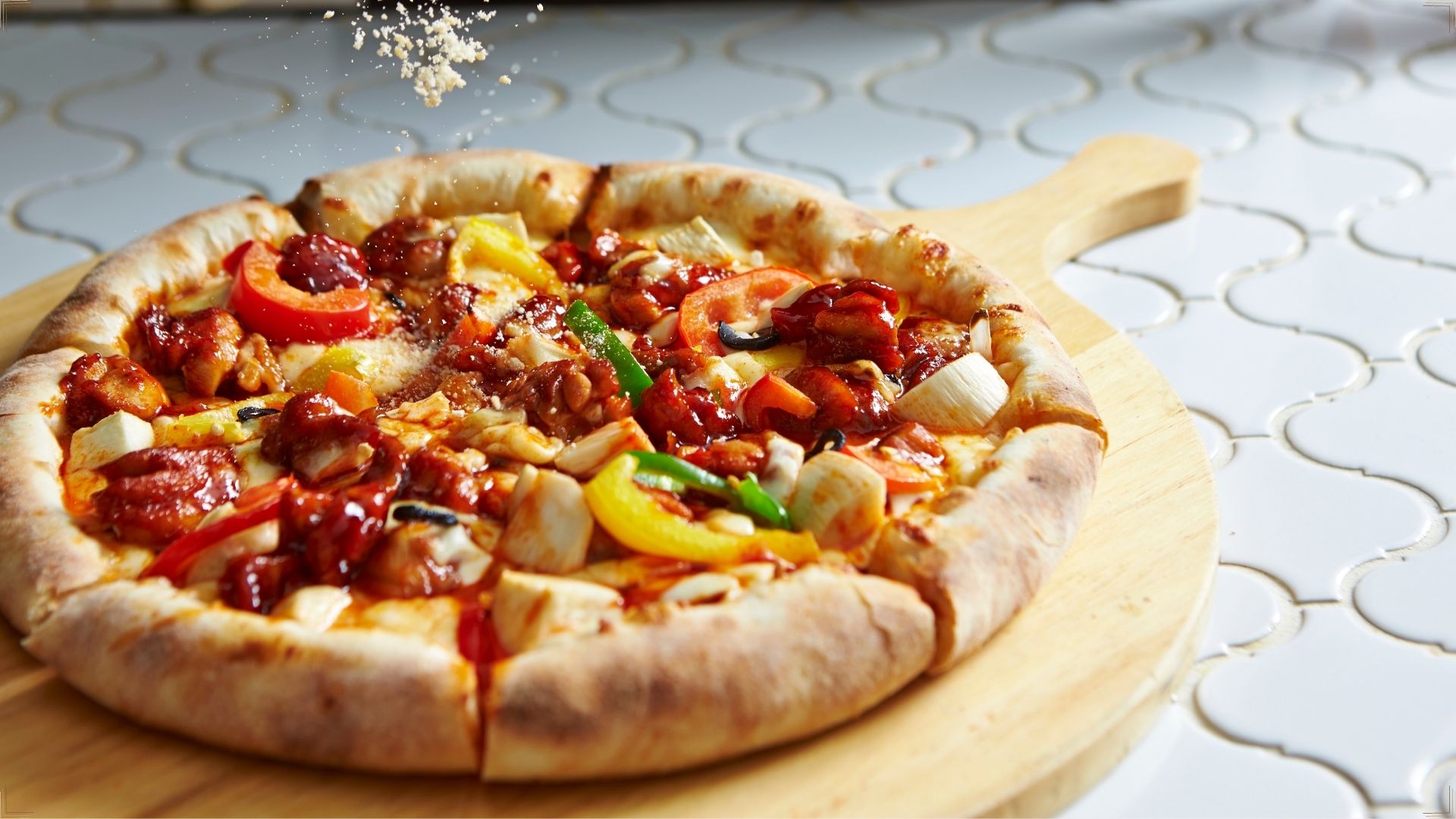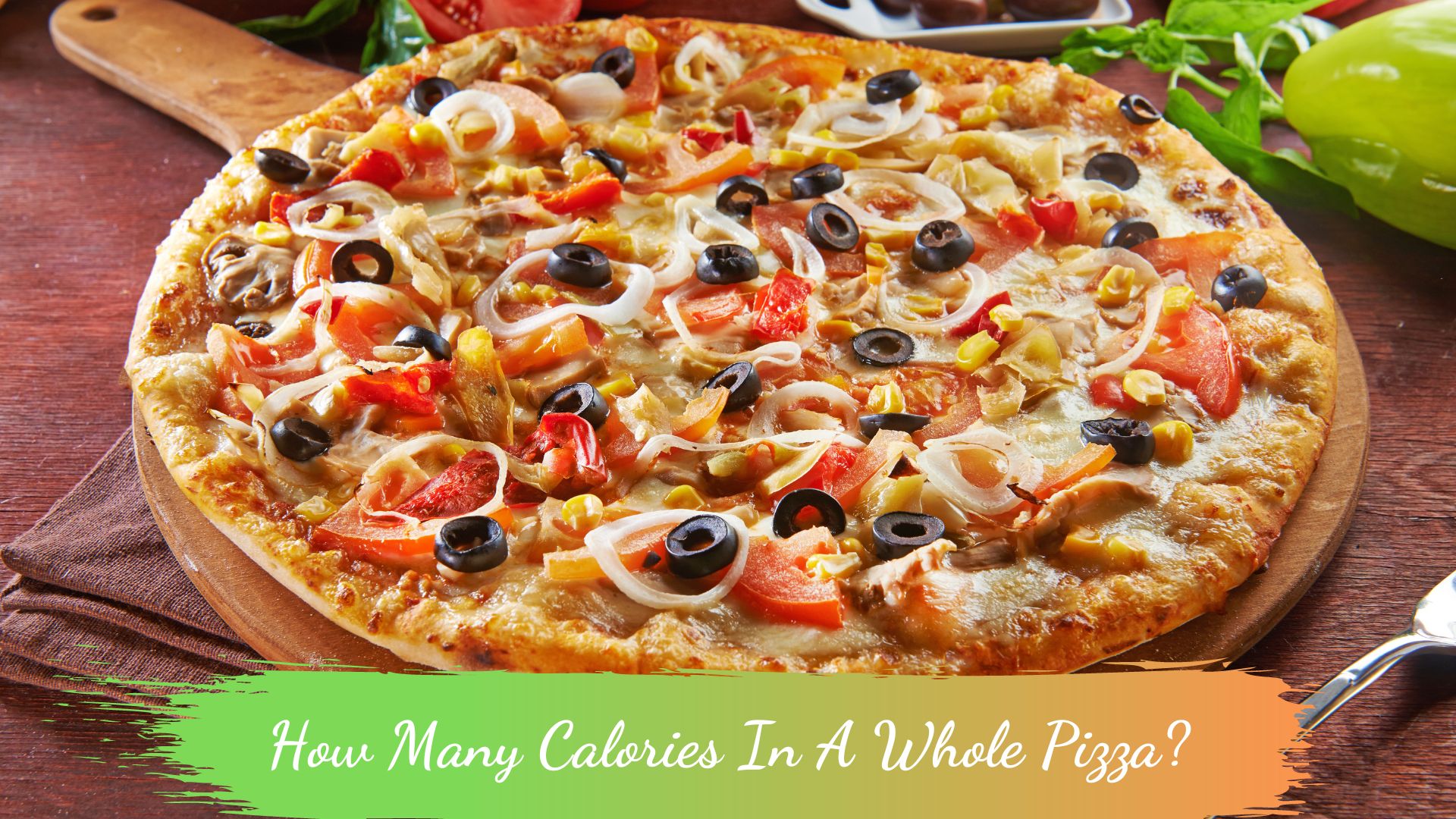How Many Calories In A Whole Pizza?
For people looking for more information about how many calories in a whole pizza, look no further! While it’s true that pizza can be an indulgence because of the delicious toppings and cheesy goodness usually associated with it, understanding just how many calories you’re consuming in one sitting can help you manage your diet. We’ll explore what factors go into determining how many calories in a whole pizza and provide tips on creating healthier options so that you can still enjoy it without the guilt. Read on to find out everything you need to know!

A Brief History Of Pizza
The history of pizza can be traced back to ancient times when flatbreads were topped with herbs, oils and other simple toppings. The modern-day version of pizza is thought to have originated in Naples, Italy, in the late 18th century. This style was called “Neapolitan Pizza” and was popularized by local street vendors and bakeries.
The popularity of pizza soon spread throughout Italy and eventually reached the United States in the late 19th century. In 1905, Gennaro Lombardi opened the first pizzeria in America in New York City. This shop is still open today and is known as “Lombardi’s” – a popular tourist destination in the city.
Pizza has become one of the most popular foods since its humble beginnings in New York City. Different countries have adapted their versions and recipes to create unique flavors that range from spicy and savory to sweet and fruity. From frozen pizza rolls to gourmet wood-fired creations, there is something for everyone to enjoy.
Today, pizza is enjoyed by people of all ages and backgrounds and can be found in restaurants, street vendors, grocery stores, convenience stores, and more. Pizza’s rich history, steeped in Italian culture and culinary tradition, will remain a beloved favorite for generations.
Why Should You Know How Many Calories In A Whole Pizza?
Knowing how many calories in a whole pizza can help you make healthier choices. Eating too many calories can lead to weight gain, so it’s important to be aware of the calorie content of your foods. A 12-inch plain cheese pizza will average contain around 800-1000 calories, depending on the size and toppings. To reduce the calories in a pizza, you can opt for vegetables or lean meats as toppings instead of processed meats and cheese or switch to low-fat mozzarella instead of full-fat cheese. Eating pizza in moderation can be part of a well-balanced diet, but it’s important to know how many calories you consume. Knowing the calorie content of a whole pizza can help you make healthier choices when it comes to eating pizza.
How Many Calories In A Whole Pizza?
How many calories in a whole pizza? The amount of calories in a whole pizza depends on the type and size of the pizza. Generally, a whole pizza can range from around 800 to over 2,000 calories. Most pizzas contain unhealthy ingredients like refined wheat flour, processed meats, and saturated fat-rich cheese. The calorie count of a pizza also depends on the toppings used – adding more of certain ingredients will add more calories.
The average 12″ cheese pizza contains 1,080 calories. This includes the crust, cheese, and sauce. Toppings like pepperoni, sausage, olives, or mushrooms can increase the calorie count to 1,440 calories per pizza.
If you’re watching your calorie intake or trying to eat healthier meals, it’s best to avoid eating whole pizzas or large slices. Consider ordering a smaller size or choosing healthier toppings like vegetables and lean proteins to minimize the calorie count. Additionally, you can always opt for a thin crust over a regular crust, as it usually contains fewer calories than its thicker alternative.
How Many Calories In A Whole Pizza From Pizza Hut?
The amount of calories in a whole pizza from Pizza Hut will depend on the pizza you order. For example, their Hand-Tossed Cheese Pizza contains 2,270 calories per whole pizza. Their Ultimate Cheese Lover’s Pizza has 3,190 calories for a whole pizza, and the Veggie Lover’s Pizza contains 2,570 calories per whole pizza. Additionally, their Meat Lover’s Pizza has 3,190 calories per whole pizza, and their Supreme Pizza contains 2,560 calories for a whole pizza. It is important to note that these amounts are based on standard menu items and do not account for additional toppings or variations in ingredients that can affect the overall calorie count of your order.
How Many Calories In A Whole Pizza From Papa John’s?
A large original hand-tossed cheese pizza from Papa John’s contains 2,820 calories. The thin crust version has slightly fewer calories at 2,560 per large pizza. Toppings such as pepperoni or sausage will add additional calories to the pizza. Depending on the number and type of toppings, a large Papa John’s pizza can contain up to 3,780 calories. The extra-large version has even more calories – 4,160 for the original hand-tossed cheese pizza and 3,910 for the thin crust with cheese.
How Many Calories In A Whole Cheese Pizza?
A whole cheese pizza can contain anywhere from 1,000 to 3,000 calories. The exact amount of calories in a specific pizza will depend on the size and thickness of the crust, as well as how much cheese and other toppings are added. For instance, a large thin-crust cheese pizza with extra cheese will have more calories than a small thick-crust pizza with just cheese. Generally speaking, an average-sized (10”) cheese pizza will contain around 1,500 calories.
How Many Calories In A Whole Margherita Pizza?
A whole Margherita pizza typically contains about 850 calories. However, this will vary depending on the size and toppings of the pizza. For example, a 12-inch Margherita pizza with traditional toppings can contain up to 1,180 calories. Some restaurants may offer lighter versions of the same pizza with fewer calories. It is important to check the nutrition information of each restaurant before ordering.
How Many Calories In A Whole Pepperoni Pizza?
A typical 12-inch pepperoni pizza contains approximately 456 grams of carbohydrates, 637 grams of total fat and 2,097 calories. Of the total fat, 216 grams are saturated. Each pizza also contains 58 grams of protein and 4 milligrams of sodium.
It’s important to note that these numbers can vary depending on the size and toppings used in a particular pizza. For instance, a larger 15-inch pepperoni pizza would contain 2,592 calories and 75 grams of protein, while a smaller 9-inch pizza would have 1,493 calories and 38 grams of protein.
How Many Calories In A Whole Seafood Pizza?
A whole seafood pizza can contain anywhere between 800 and 1,200 calories, depending on the ingredients used. Generally speaking, a large seafood pizza with a 12-inch diameter will contain around 850 calories.
How Many Calories In A Whole Veggie Pizza?
A large veggie pizza with a 12-inch diameter will typically contain around 600 calories. This number can vary significantly depending on the types and amount of vegetables used and other ingredients such as cheese and sauces. The calorie count may be higher or lower, depending on these factors.
How Many Calories In A Whole Hawaiian Pizza?
A large Hawaiian pizza with a 12-inch diameter typically contains around 800 calories. This is based on the standard toppings of ham, pineapple and cheese. It can vary depending on the quantity and type of ingredients used.
How Many Calories In A Whole Pizza With Multiple Meat?
How many calories in a whole pizza with multiple types of meat? The number of calories in a whole pizza with multiple meat toppings depends on the type of crust, size, and toppings. A large pizza can contain up to 3,000 calories or more! Toppings such as pepperoni, sausage, beef, bacon and ham can add 500-700 calories per topping. Some pizzas may also contain cheese, which can add hundreds of calories. Therefore, it is important to consider all the ingredients when calculating the total calorie content of a pizza with multiple types of meat.
Reasons Pizza Has A High-Calorie Content
Here are some reasons why pizza has high-calorie content:
- Pizza is typically made with high-fat ingredients like cheese and sausage. Cheese is especially calorie-dense; a single slice can contain up to 200 calories from just the cheese alone.
- Pizza usually contains oil or butter to help it cook properly and prevent sticking in the oven. The fat content in this oil or butter further increases the calorie count.
- Pizza dough is often made with white flour, which does not contain much nutrition and offers empty calories. The dough can be a significant source of calories due to its high carbohydrate content.
- Many pizzas are topped with processed meats, such as pepperoni or sausage. These contain significant amounts of sodium and saturated fat, which can further increase the calorie content.
- Many pizzas are also covered in high-fat sauces, such as ranch dressing or a creamy garlic sauce. These toppings add additional calories to the pizza without providing much nutrition.
Low-Calorie Pizza Varieties
Pizza can often seem like an off-limits indulgence when trying to eat a healthy diet. But with a few smart choices, it doesn’t have to be! There are several ways to turn a traditional pizza into a low-calorie meal that still satisfies your craving for cheesy goodness.
For starters, you can make your own pizza at home and control the ingredients. Top a thin-crust base with reduced-fat cheese, lean meats like turkey or chicken, fresh vegetables like peppers and onions, and herbs for flavor. This will help create a healthier version of an otherwise unhealthy treat.
Another way to make a healthier pizza is by opting for frozen varieties made with whole-wheat crusts and reduced-fat cheese. These pizza options can provide the same delicious taste as a traditional pie but with fewer calories and fat.
If you’re looking for an even lower-calorie option, consider thin-crust varieties that are made with cauliflower or quinoa bases. Packed with fiber and vitamins, these ingredients provide more nutrition while reducing calories.
Nutrition Facts Of A Whole Pizza
Serving Size: 1/8 of a pizza (142g)
Calories: 340
Total Fat: 14g
Saturated Fat: 6g
Cholesterol: 30mg
Sodium: 670mg
Total Carbohydrates: 37g
Dietary Fiber: 2.5g
Sugars: 2g
Protein: 11g
Vitamin A: 8% DV
Vitamin C: 0% DV
Calcium: 10% DV
Iron: 15% DV
Expert Tips For Limiting Calories When Eating Pizza
- Opt for thin-crust pizza. Thin-crust pizzas have fewer calories as they don’t contain as much dough.
- Choose lower-calorie toppings like vegetables and lean meats rather than high-fat ingredients such as pepperoni, sausage or cheese.
- Avoid extra sauces, such as alfredo or pesto, which can add extra calories.
- Ask for the toppings to be cooked with less cheese and instead add more vegetables like mushrooms, bell peppers, onions and spinach.
- Limit your portion size by only eating one slice of pizza rather than multiple slices. This will help you stay within your calorie limit without feeling deprived.
- Choose a whole-wheat pizza crust for added fiber and nutrients. Whole-wheat pizza crusts are typically lower in calories than white flour crusts, which contain more refined carbohydrates.
- To reduce your caloric intake even further, ask for half the cheese or request that your pizza be made with a light coating of olive oil instead of cheese.
- If you’re eating pizza out, ask the restaurant to serve it on a plate rather than in a box. Eating from a plate will help you practice portion control and keep track of how much you are consuming.
- Make your own pizza at home. This way, you can control the ingredients and amounts used, ensuring you eat healthier.
- Add fat-free plain Greek yogurt to your pizza slice for added protein and calcium. The tangy flavor will also help to cut down on the richness of the pizza without adding extra calories.
Common Mistakes To Avoid About How Many Calories In A Whole Pizza
- Not Checking the Size – Regarding pizza, size does matter. A small pizza can contain around 200-300 calories, while a large pizza can have up to 500 calories or more. Be sure to check how big your slice is before you start eating.
- Ignoring the Toppings – Different toppings like pepperoni, sausage, and bacon can add up to 250 calories. If you’re trying to watch your calorie intake, it’s best to stick to cheese pizzas or opt for veggie toppings like bell peppers and mushrooms.
- Not Taking Into Account the Sauce – The sauce used on the pizza can also influence how many calories you consume. For example, white sauces usually contain more fat and calories than red sauce, so it’s best to avoid them if you’re dieting.
- Underestimating Portion Size – When counting calories, one of the most common mistakes people make is underestimating their portion size. A single slice of pizza can easily contain over 200 calories. So, if you’re trying to watch your calorie intake, it’s best to stick to one or two slices instead of three or four.
- Eating the Crust – The crust is usually the most calorie-dense part of the pizza. Not only does it contain more calories, but it’s also higher in fat and carbohydrates. Avoid eating the crust if you’re trying to watch your calorie intake.
- Not Eating Vegetables – Adding veggies to your pizza is a great way to increase your nutrient intake without adding too many calories. Add spinach, bell peppers, mushrooms, or onions for added vitamins and minerals to your pizza.
FAQs About How Many Calories In A Whole Pizza
What Pizzas Are Healthy For Diabetics?
Diabetics should choose pizzas with low fat and sugar levels and lower carbohydrate content. Whole wheat crusts or thin crusts are best. Topping choices should include vegetables, lean proteins such as chicken, turkey, fish, and reduced-fat cheeses.
Can You Eat Pizza While Reducing Weight?
Yes, pizza can be part of a weight-loss diet plan. While it is high in calories and fat content, it can still be enjoyed as an occasional treat. If you want to reduce your calorie intake but still enjoy pizza, several options are available.
How Many Servings Can A Whole Pizza Provide?
This depends on a few factors, such as the size of the pizza and how many slices are cut from it. Generally, a large pizza with 8 slices will provide 4-6 servings. A medium-sized pizza with 6 slices will provide 3-4 servings, while a small pizza with 4 slices will provide 2-3 servings.
Can You Lower A Homemade Pizza’s Calories?
Yes, there are several ways to lower the calorie count of a homemade pizza. You can use thin-crust dough and fewer toppings lower in fat and calories, like vegetables, lean meats, and low-fat cheese. Additionally, you can bake the pizza instead of frying it for a healthier option.
Can You Eat A Whole Pizza Once A Day?
No, eating a whole pizza once a day is not recommended. Eating too many calories can lead to weight gain and an increased risk for health problems. If you want to eat a whole pizza daily, try spreading it out over several days or cutting down on portion size.
How Many Calories Are There In One Small Pizza?
A small pizza typically ranges from 200-400 calories, depending on the topping and size. On average, a medium-sized cheese pizza contains about 495 calories. To cut down on calories, opt for thin crusts and light toppings.
Can Consuming A Whole Pizza Cause Diabetes?
Unfortunately, consuming a whole pizza is not recommended if you risk developing diabetes. A large amount of carbohydrates can spike your blood sugar levels and cause long-term health issues.
How Many Calories Are There In One Medium Pizza?
On average, one medium pizza contains around 8 slices and has a total of approximately 1150 calories. This number can vary depending on the size and ingredients used. For example, a cheese-only pizza typically contains slightly fewer calories than one with multiple toppings.
Is Pizza Healthy?
Pizza can be a healthy food choice when it is made with wholesome ingredients. Eating pizza in moderation and choosing vegetable-rich toppings can make pizza nutritious. However, some pizzas are high in calories, saturated fat, sodium and added sugars, making them an unhealthy choice.
Can Pizza Give Me The Nutrients I Need?
Pizza can provide some of the essential vitamins and minerals your body needs, but it should not be used as a main source of nutrition. You should include other nutrient-rich foods besides pizza to get adequate daily nutrients. Additionally, topping choices such as vegetables, lean proteins, or low-fat cheese will help ensure you get the right nutrients. Try pairing your pizza with a side salad or vegetables to get a balanced meal.
Conclusion On How Many Calories In A Whole Pizza
Overall, how many calories in a whole pizza can vary greatly depending on the toppings and size. A whole pizza typically ranges from around 800 to over 2,000 calories. Regarding caloric intake, it’s important to consider the entire meal, so remember to factor in side dishes and drinks. Choose a thin-crust pizza with vegetable toppings, like mushrooms or onions, to save calories. Additionally, eating smaller slices can help reduce the total calorie intake. Eating the appropriate portion size is key to eating healthfully and maintaining a balanced diet. With careful consideration and mindful eating, choosing the right type of pizza can help you stay healthy and enjoy your favorite food.
References:
https://www.wikihow.com/Make-Pizza-from-Scratch
https://en.wikipedia.org/wiki/Pizza
https://www.nps.gov/articles/pizza-in-usa.htm

